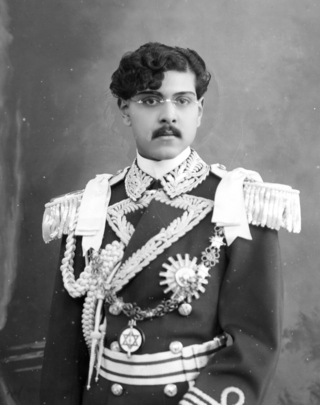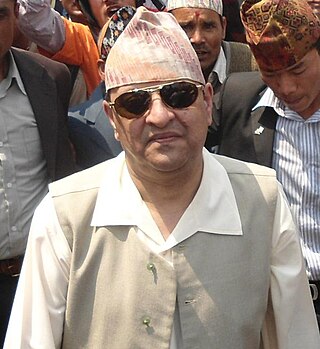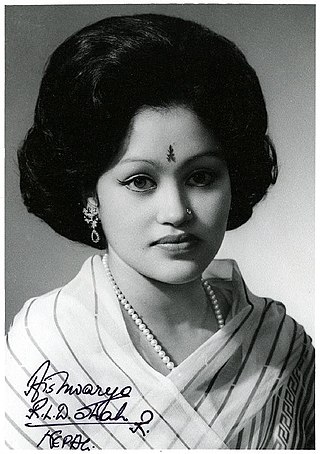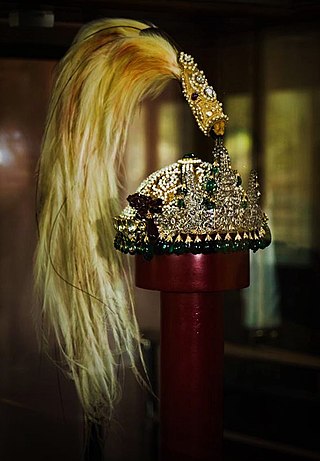Related Research Articles

Kathmandu, officially the Kathmandu Metropolitan City, is the seat of federal government and the most populous city in Nepal. As of the 2021 Nepal census, there were 845,767 inhabitants living in 105,649 households and approximately 4 million people in its surrounding agglomeration. It is located in the Kathmandu Valley, a large valley surrounded by hills in central Nepal, at an altitude of 4,344 feet above sea level.

Tribhuvan Bir Bikram Shah Dev, was King of Nepal. Born in Kathmandu, the capital city of Nepal, he ascended to the throne at the age of five, upon the death of his father, Prithvi Bir Bikram Shah, and was crowned on 20 February 1913 at the Nasal Chowk, Hanuman Dhoka Palace in Kathmandu, with his mother acting as regent. At the time of his crowning, the position of monarch was largely ceremonial, with the real governing power residing with the Rana family.

Dipendra Bir Bikram Shah Dev was King of Nepal for three days from 1 to 4 June 2001. For the duration of his three-day reign he was in a coma after the shooting at his father King Birendra, his mother Queen Aishwarya, his younger brother and sister, five other members of the royal family, and himself in an event known as the Nepalese royal massacre. Upon Dipendra's death, his paternal uncle Gyanendra became king.

Birendra Bir Bikram Shah Dev, was King of Nepal from 1972 until his assassination in 2001. He was the eldest son of King Mahendra.

Gyanendra Bir Bikram Shah Dev was the last King of Nepal, reigning from 2001 to 2008. As a child, he was briefly king from 1950 to 1951, when his grandfather, Tribhuvan, took political exile in India with the rest of his family. His second reign began after the 2001 Nepalese royal massacre. Gyanendra Shah is the first person in the history of Nepal to be king twice and the last king of the Shah dynasty of Nepal.
Prince Nirajan Bir Bikram Shah Dev was a prince of Nepal, the younger son of King Birendra and Queen Aishwarya of Nepal. He and his parents were killed during the 1 June 2001 Nepalese royal massacre.

Aishwarya Rajya Lakshmi Devi Shah was the Queen of Nepal from 1972 to 2001, also referred to as Bada Maharani (बडामहारानी). She was the wife of King Birendra and the mother of King Dipendra, Prince Nirajan, and Princess Shruti. She was the eldest among the three daughters of the late General Kendra Shumsher Jang Bahadur Rana and Shree Rajya Lakshmi Devi Shah in Lazimpat Durbar, Lazimpat, Kathmandu.
Princess Shruti Rajya Lakshmi Devi Shah of Nepal was the daughter of King Birendra and Queen Aishwarya, and sister of King Dipendra and Prince Nirajan.

The Shah dynasty, also known as the Shahs of Gorkha or the Royal House of Gorkha, was the ruling Chaubise Thakuri dynasty and the founder of the Gorkha Kingdom from 1559 to 1768 and later the unified Kingdom of Nepal from 1768 to 28 May 2008.

Ratna Rajya Lakshmi Devi Shah is a member of the Nepalese royal family who was queen consort of Nepal from 1955 to 1972 and queen dowager from 1972 to 2008 when the royal family were stripped of all titles and privileges. She is the second wife of King Mahendra (1920–1972). Ratna belongs to the aristocratic Rana family and is the daughter of Field Marshal Hari Shamsher Jang Bahadur Rana and his wife, Megha Kumari Rajya Lakshmi.

Komal is a member of the Nepalese royal family who was the last Queen of Nepal as the wife of King Gyanendra of Nepal until the monarchy was abolished on 28 May 2008. She is also known by the name Komal Shah.

The Nepalese royal massacre occurred on 1 June 2001 at the Narayanhiti Palace, the then-residence of the Nepali monarchy. Nine members of the royal family, including King Birendra and Queen Aishwarya, were killed in a mass shooting during a gathering of the royal family at the palace. A government-appointed inquiry team named Crown Prince Dipendra as perpetrator of the massacre. Dipendra slipped into a coma after shooting himself in the head.

The Narayanhiti Palace Museum is a public museum in Kathmandu, Nepal located east of the Kaiser Mahal and next to Thamel. The museum was created in 2008 from the complex of the former Narayanhiti Palace following the 2006 revolution. Before the revolution, the palace was the residence and principal workplace of the monarch of the Kingdom of Nepal, and hosted occasions of state.
Prince Dhirendra Bir Bikram Shah Dev of Nepal was the youngest son of King Mahendra of Nepal and his first wife, Crown Princess Indra.

The coronation of the Nepalese monarch was a rājyābhiṣeka, a Hindu religious ceremony in which the King of Nepal was crowned. The last coronation was held on 4 June 2001 for King Gyanendra. The Kingdom of Nepal was the last Hindu monarchy in the world at the time of its dissolution in 2008.

The Order of the Million Elephants and the White Parasol, also called the Order of the Million Elephants and the White Umbrella, is the highest knighthood order of the Royal Family of Laos.
Princess Shova Shahi of Nepal or Shova Rajya Lakshmi Devi is a former princess of Nepal. She is the youngest daughter of King Mahendra of Nepal. She is the only surviving daughter of King Mahendra; her older sisters Princess Shanti and Princess Sharada were murdered during the Nepalese royal massacre along with King Birendra Bir Bikram Shah Dev and his family.

General Prince Narendra Bikram Shah was the second son of King Surendra. The prince was exiled to India because of his involvement in a conspiracy against the Rana dynasty.
The Tribhuvan Sadan is a mansion in the Narayanhiti Palace, Kathmandu, Nepal. It is known for being the site of the Nepalese royal massacre where ten members of the royal family, including King Birendra, Queen Aishwarya, and Crown Prince Dipendra were killed. The mansion was formerly occupied by King Tribhuvan and his family and later by Dipendra, Crown Prince of Nepal. The Tribhuvan Sadan was demolished after the orders of the Queen Mother Ratna however It is currently being reconstructed.

Birendra was crowned as the tenth King of Nepal on 24 February 1975, at the age of 29. The coronation was held two years after the death of his father, King Mahendra because the first year was a year of mourning period and the next was considered inauspicious by court astrologers. Representatives from 60 nations attended the ceremony.
References
- 1 2 3 4 "Nepalese Prepare for a Royal Wedding - The New York Times". The New York Times. 25 February 1970. Retrieved 2022-01-21.
- 1 2 3 4 "Nepal: Marriage of Convenience". Time. 1970-03-09. ISSN 0040-781X . Retrieved 2022-01-21.
- ↑ "Wedding Ceremony of King Birendra of Nepal". 2019-12-06. Retrieved 2022-01-21.
- ↑ Templeman, David (2016). "Crown Prince Birendra of Nepal's Wedding Celebration". Monash University. doi:10.4225/03/57E20BAD62F09 . Retrieved 2022-01-21.
{{cite journal}}: Cite journal requires|journal=(help)